#importance of structured data
Explore tagged Tumblr posts
Text
Why Semantic SEO Is Crucial For E-Commerce Success
Why Semantic SEO Is Crucial For E-Commerce Success Search engine optimization (SEO) is a crucial aspect of e-commerce success, as it determines how visible your website is in search engine results. Semantic SEO, also known as contextual or intent-based SEO, is a relatively new approach that focuses on the context and meaning behind search queries. By understanding the intent of the searcher,…
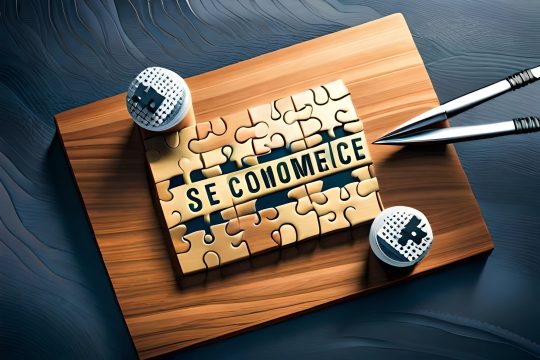
View On WordPress
#analytics tracking#Analyzing customer behavior#Benefits of semantic SEO in E commerce#Challenges of implementing semantic SEO in E commerce#Impact of Mobile Optimization on Semantic SEO#impact of voice search on semantic SEO#importance of structured data#Improving conversions#keyword research#measuring effectiveness#Role of AI in Semantic SEO#Schema markup#Semantic search benefits#User behavior analysis#User intent analysis#voice search optimization
0 notes
Text
AI HIGH TICKET COMMISSIONS

#Our advanced AI platform offers automated tools that optimize your sales strategy#ensuring you close high-value deals effortlessly.#By leveraging our AI tools#you’ll not only save time but also increase your conversion rates#allowing you to earn higher commissions without the extra effort.#Perfect for sales professionals#entrepreneurs#and marketers looking to maximize their income and streamline their processes.#‘Since using this AI platform#my commissions have doubled!’ – Sarah#Top Sales Rep.#it’s important to highlight key features and benefits that appeal to potential buyers. Here are some suggestions for how to structure your d#1. **Attention-Grabbing Intro**#- Start with a bold statement or question to capture interest.#- Example: “Unlock your earning potential with our exclusive AI-driven commission program!”#2. **Product Overview**#- Briefly describe what the product is and what it does.#- Example:#3. **Key Features**#- **Smart Analytics**: Utilize data-driven insights to identify your best prospects.#- **Seamless Integration**: Effortlessly connect with your existing CRM and marketing tools.#4. **Benefits**#- Explain how these features translate into real-world benefits.#5. **Target Audience**#- Identify who will benefit most from the product.#6. **Testimonials or Success Stories**#- Include quotes or case studies from satisfied customers.#7. **Call to Action**#- Encourage readers to take the next step#whether it's signing up or learning more.
1 note
·
View note
Note
I've seen you say a few times that it's a good idea to have a password manager; could you explain why? I always feel like I'm missing something when it's mentioned because it's phrased as if there's an obvious danger that password managers protect you from, but I'm honestly not sure how they help keep passwords secure.
The obvious danger is human nature. Humans are bad at creating passwords; your passwords are almost certainly easy to guess, repeated across different accounts, or both, because that is just how the vast VAST majority of people create passwords, because humans are bad at creating passwords. Everybody knows "the rules" for creating passwords (don't use the same password on multiple websites, don't include personal details in your passwords, don't use very common words or letter or number sequences in your passwords, don't tell other people your password) and people break all of those rules anyway.
A standalone (not in-browser like firefox or chrome password manager, though those are better than nothing) password manager stores your passwords, generates complex passwords for you, and can also be used for things like storing notes on passwords (like "did I put my MFA on my email or my cellphone or an app for this password?" or "here are the made-up answers to the security questions I used for this website because I definitely didn't use real answers or answers I'd used on previous websites" or "these are the bills associated with this credit card").
With the way the current security landscape works, there are two things that are extremely important when you are creating a password:
Uniqueness
Complexity
The overwhelmingly prevalent way that people get "hacked" these days is through credential stuffing.
Let's say that your private data was revealed in the Experian breach a decade ago. It revealed your name, email address, and phone number. Now let's also say that your private data was revealed in one of the many breaches from social media sites; that one revealed your name, email address, phone number, password, and security questions.
If someone wants to try to gain access to one of your accounts - let's say your bank account - if they have your name and phone number (usually extremely easy to find online), they can cross-reference that information with data that has been revealed in previous breaches - now they've got your name and your email address (which you probably used to sign up for your online banking and have ABSOLUTELY used as your login for accounts all over the place) and at least one password that you've used somewhere.
But the thing is, they don't have one password. They have every password associated with that email address that has ever been revealed in a breach. If you go to the site haveibeenpwned.com you can enter your email and see how many times your email address has appeared in a breach. You can compare that with the number of passwords that were revealed in those breaches and you can ask yourself "what did those passwords have in common?"
Because I can tell you, my Tumblr password from 2013, my Kickstarter password from 2014, and my Disqus password from 2017 (all revealed in various breaches) probably had a lot in common.
So, now the hacker has: your name, your email (which is probably your username), and various passwords they can try to use to log in. Did you use the same password for Facebook and Twitter eight years ago? Did you use parts of that password for creating your bank password? If you heard that twitter passwords were exposed in a breach you probably changed that password, but did you change the bank password that you built on the same structure? Probably not.
So what people will do is gather up all of this information and guess. They'll try your 2017 Disqus password to see if it will get access to your bank account. They'll try your 2020 Gravatar password. They'll try your 2024 Internet Archive Password.
And the reason they do this is because it works.
And the reason that it works is because we are all fucking garbage at remembering unique, complex passwords so instead of creating actually unique, complex passwords most people pick one memorable word or phrase, one memorable number, one unusual character, and *MAYBE* one feature of the site they're creating the login for and they use that template forever (1988Tumblrmacabre!, 1988Facebookmacabre!, 1988Ticketmastermacabre!) OR they create one password that they think is complex enough and use it across multiple sites with minor tweaks ($n0h0mi$hRu13z, sn0h0mishRul13z!, $n0h0mi$hWA) as needed for the sites' password requirements.
So most of what password managers do that is a drastic security improvement over people creating and memorizing passwords is that they create passwords that are functionally impossible to guess and functionally impossible to memorize. The problem with memorizing passwords (which is what you're doing if you're creating a bunch of passwords that you type in all the time) is that you can't actually remember all that many passwords so you'll repeat those passwords. The problem with creating passwords on your own is that passwords that humans create are pretty guessable. Even if you're doing a passphrase that's a long string of words you're probably working with common words ("correct horse battery staple" as opposed to "truculent zygote onomatopoeia frangible") and your password is more guessable than you'd really want it to be. Password managers don't do that, they generate gibberish.
Perhaps you are that rare person who gets out a set of dice and a notepad and rolls up every character for your password and memorizes it and never repeats, and if that's you, you could still benefit from a password manager because a password manager makes it easier to change that unique complex password when it is inevitably revealed in a breach.
So, okay, let's check in with where we're at:
Password managers mean that you don't have to memorize your password, which means that you don't need a password that is easy to memorize, which means that they can create passwords that are extremely complex and are therefore very difficult to guess. This protects you from crackers who will try to brute force your password.
Password managers mean that you don't have to remember extremely complex passwords for every account, which means that you are less likely to repeat your password in whole or in part across multiple accounts. This protects you from credential stuffers, who will try to use your password from one account that was revealed in a breach to open other accounts that were not.
Because password managers can generate and store complex passwords essentially instantly, you can replace passwords nearly effortlessly when there is a breach (no need to 'come up with' a new password, no issues with learning or memorizing it).
There are, however, advantages beyond that.
One major, MAJOR advantage of a properly-used standalone password manager is that it makes you safer from various kinds of phishing attempts and link hijacking. When you are setting up a password in your password manager (PWM from here on), you should be on the website that you want to log in to. The PWM will give you the option to save the domain that you're logging in to. That means the PWM will remember the correct URL for your Tumblr login so when you go to the tumblr login screen in the future, it will offer to fill those fields. What it will NOT do is offer to fill those fields if someone sends you an email that spoofs tumblr support and wants you to log in at "tumblr.co" or "tumblr-support.com." Knowing this, and knowing that you should be putting your credentials in through the PWM fill option rather than copy/paste, is a GREAT way to protect against phishing that is often overlooked and definitely under-discussed.
Another advantage is that a standalone PWM will let you store secure notes with your passwords so that you can do things like keep track of recovery codes for the website, or generate gibberish answers to security questions. Security questions and answers are often revealed in breaches, can't be reset by the user as easily as a password, are repeated across websites MUCH more than passwords, and can be used to take over an account and reset the password. You shouldn't be giving real security answers, or even fake-but-repeated security answers; you should treat each of those like a password that needs to be complex and unique, which means that they need to be stored someplace (like a password manager).
I also personally use my password manager to store my car insurance information, my driver's license info, and payment details for easy entry, making it convenient for a lot of thing beyond password storage. (Bitwarden. My password manager is bitwarden. I recommend Bitwarden. go to ms-demeanor.com and search "bitwarden" to learn more.)
As to how they keep your passwords safe, aside from ensuring that you don't enter your credentials into a skimming site, a good password manager is well encrypted. Your password safe should be functionally impossible to crack and what people tend to not realize is that a proper password manager (like bitwarden) doesn't keep all your passwords in one encrypted safe, each one of your passwords is in its own encrypted safe. If someone hacks Bitwarden it's not like using a huge amount of effort breaking into a bank vault and finding a big pile of money, it's like using a huge amount of effort breaking into a bank vault and finding a big pile of bank vaults. Each password within your vault requires decryption that is functionally impossible to crack (at least with a good password manager, like bitwarden, the password manager I recommend and think that people should use).
Additionally, just as, like, a side note: password managers never accidentally leave caps lock on or forget which characters are capital or lower case and don't require the use of two hands and focused attention on the keyboard. You're never going to mistype your password if the password manager is filling it, and you would not believe the number of people we support at work who require password resets because they are typing their password wrong and don't realize it.
TL;DR:
Password managers make better passwords than you can and they make it possible to instantly create, store, and enter complex passwords, which prevents password cracking and makes people less likely to reuse passwords. They are heavily encrypted and should be functionally impossible to access, and each individual password within the manager should also be encrypted if you use a good password manager. Password managers also prevent people from entering their credentials on scam sites by only filling on matched domains. Standalone password managers (not browser password managers) also allow users to create and store unique security questions and account details to prevent bad actors from gaining access with stolen security answers. The password manager I recommend is Bitwarden.
If people used password managers to create, store, and use unique and complex passwords, and if they did regular backups of their system I think that probably about half of the InfoSec field would be out of a job.
Please use a password manager!
2K notes
·
View notes
Text
"A new study reveals the profound ecological effects of wolves and other large carnivores in Yellowstone National Park, showcasing the cascading effects predators can have on ecosystems. In Yellowstone, this involves wolves and other large carnivores, elk, and willows.
The research, which utilized previously published data from 25 riparian (streamside) sites and collected over a 20 year period, from 2001 to 2020, revealed a remarkable 1,500% increase in willow crown volume along riparian zones [note: riparian means in/around rivers] in northern Yellowstone National Park, driven by the effects on elk due to a restored large carnivore guild following the reintroduction of wolves in 1995–96, and other factors...

Pictured: Upstream view of Blacktail Deer Creek in 2005 and 2021, northern range of Yellowstone National Park.
Trophic cascades, the effects of predators on herbivores and plants, have long been a topic of ecological interest. The study quantifies the strength of this phenomenon for the first time using willow crown volume as a proxy for aboveground biomass, demonstrating a significant three-dimensional recovery of riparian vegetation represented by the growth in both crown area and height of established willows.
The strength of the Yellowstone trophic cascade observed in this study surpasses 82% of strengths presented in a synthesis of global trophic cascade studies, underscoring the strength of Yellowstone's willow recovery process. The authors note that there is considerable variability in the degree of recovery and not all sites are recovering.
Even though riparian areas in the western United States comprise a small portion of the landscape, the study has particular relevance since these areas provide important food resources and habitat for more wildlife species than any other habitat type. These areas also connect upland and aquatic ecosystems and are widely known for their high diversity in species composition, structure, and productivity.
"Our findings emphasize the power of predators as ecosystem architects," said William Ripple. "The restoration of wolves and other large predators has transformed parts of Yellowstone, benefiting not only willows but other woody species such as aspen, alder, and berry-producing shrubs. It's a compelling reminder of how predators, prey, and plants are interconnected in nature."
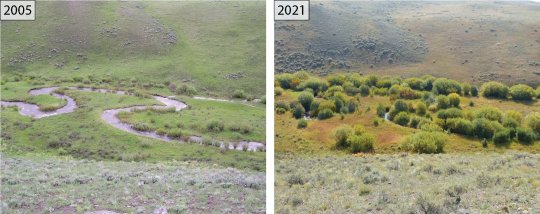
Pictured: An across channel view in 2005 and 2021 of a downstream reach on Blacktail Deer Creek, northern range of Yellowstone National Park.
Wolves were eradicated and cougars driven to low numbers from Yellowstone National Park by the 1920s. Browsing by elk soon increased, severely damaging the park's woody vegetation, especially in riparian areas. Similar effects were seen in places like Olympic National Park in Washington, and Banff and Jasper National Parks in Canada after wolves were lost.
While it's well understood that removing predators can harm ecosystems, less is known about how strongly woody plants and ecosystems recover when predators are restored. Yellowstone offers a rare opportunity to study this effect since few studies worldwide have quantified how much plant life rebounds after large carnivores are restored.
"Our analysis of a long-term data set simply confirmed that ecosystem recovery takes time. In the early years of this trophic cascade, plants were only beginning to grow taller after decades of suppression by elk. But the strength of this recovery, as shown by the dramatic increases in willow crown volume, became increasingly apparent in subsequent years," said Dr. Robert Beschta, an emeritus professor at Oregon State University.
"These improving conditions have created vital habitats for birds and other species, while also enhancing other stream-side conditions."
The research points to the utility of using crown volume of stream-side shrubs as a key metric for evaluating trophic cascade strength, potentially advancing methods for riparian studies in other locations. It also contextualizes the value of predator restoration in fostering biodiversity and ecosystem resilience."
-via Phys.org, February 6, 2025
#wolves#willow tree#trees#yellowstone#yellowstone national park#united states#north america#ecosystem#ecology#ecosystem restoration#wildlife#rivers#riparian#good news#hope
1K notes
·
View notes
Text
A homebrew Iliad project
I've been fiddling with this for a long time.
Backstory: I've been dabbling in various depths of the great wine-dark sea of the ancient Greek classics since I was about seven or eight. (Might have been earlier, but I have no data to confirm that.)
I know Greek mythology like the back of my hand. (...Insert here the inevitable sound of Scotty whacking his head into an Enterprise bulkhead.) I know... a lot. And—leaving all the other stuff I know about that no one here is gonna care about one way or the other—I've read the Iliad and Odyssey probably about twice a year for the last fifty years or so. Or maybe more.
To my grief, I don't have enough classical Greek (or good enough Greek of any kind) to do any kind of respectable new translation of the work. That's far beyond my scope, or my level of scholarship. But I can sure as hell do... a retelling? A restatement? I have a number of favorite translations to use as guides, and the Perseus digital library... and, you know, dictionaries. And I'm not afraid to use them. :)
...And I'm a storyteller, and have no shame about the possibilities inherent in going where lots of others of my tribe have gone before—in restatement or in fiction. So let's just call this "a homebrew version of a work that hasn't been out of 'print' for thirty-five hundred years" and leave it there. (Is this ὕβρις? Yeah, seems likely enough. Whether this is going to be a manifestation of the downfall of the Greeks, or of the Geeks, remains to be seen.)
Anyway: my plan is to start publishing books (i.e., chapters) of this homebrew Iliad in the Fic Foundry writing website that will be opening up at last sometime over the next couple of months. The first few books will be open-access: after that they'll go subscription. They'll come out at irregular intervals (because there'll be paying work going on as well. [resigned sigh: So what else is new.])
When starting a project like this it seems like it might be wise to, in a general way, set out the goals.
Ease of accessibility. Lots of people have never read this story, or have experienced it only in one kind or another of paraphrase. (Yeah, well, here comes another one.) For maximum accessibility, I think this means what I want to do is a prose retelling. Nor am I going to get too hung up on anachronisms in the prose style. I'm reaching for the around-the-campfire sound, a little; or the story told after dinner, in episodes (and let's not throw the beef bones at the bard, she's doing the best she can).
Fidelity to the source material. This is an old, old story that both ascends to surprising heights of feeling and amazing depths of cruelty. There are things in it that some modern readers are not going to like at all: particularly the graphic gore and violence of what is repeatedly described as "the world's greatest war story". But these aspects of the Iliad, and the frequently callous, cruel and misogynistic understructure of its story, come with the territory of the original. I will in appropriate ficcer's style add trigger warnings where I think they're needed.
Completeness of the story. The temptation is always going to lurk for an adapter to decide what's important and what can be thrown out. I'm hardly immune. But it's my intention to leave the structure as intact as possible. Some people will disagree with my choices. (shrug) People have been disagreeing about ways to handle this work for centuries. What'll a few more be, among friends?
...So that's the plan. When this material starts to be ready to appear online, I'll let people here know where they need to go to access it. And after that... we'll see how things go.
I'll start this story as its first tellers did, and ask the Goddesses of epic storytelling to stand by me and lend a hand telling this one. At the end of the day, it all comes down to one angry young man: Achilles, only son of King Peleus. Achilles was completely possessed by a bitter rage that brought a whole host of troubles down on the great army of the Greeks. That unquenchable fury sent many a strong man’s soul to the Underworld, and left their bodies feeding the dogs and the vultures, while Heaven’s intentions moved inexorably on toward the Gods’ final goal...
480 notes
·
View notes
Text
An Apprentice’s (Unofficial) Guide to House Garments
based on @energ00n 's apprentice AU! (i'm obsessed with the concept of apprentices making up garment rules)
Wc: 2.1k
The datapad—an older model with discolored spots, showing where servos touched its framing—is the first thing Orion Pax’s optics land on as he walks into his new room. Orion snatches the datapad and tilts his helm as he reads the title over again. A peek at the contents shows that it begins with Hey newbie followed by three exclamation glyphs (an overabundance of any glyph, if you asked Orion).
Orion glances up and catches his own gaze in a mirror hanging in front of him. It’s strange, seeing two sheer fabric pieces delicately flowing over the hard metal of his arms—he’s hesitant to move his arm joints in fear of tearing it. That, as well as the jewelry occupying the space where his cog would be creates a vision that’ll take some getting used to.
He pries his optics away and down to the datapad again, dermas pinching as his processor whirrs. Prima explained to him how to care for his garment personally and what if, since the datapad looks old, the data was outdated? No, safer to follow Prima’s instructions and not confuse himself.
Orion places the datapad to the side and sets off to explore his new home.
~
Hello newbie!!!
Congratulations to you and your new position! There’s so much you need to know before you get started. If you wanna make friends, then you’ll wanna keep reading, little mech!
It’s most important that you know about your House garment. No, no, not how to wash oil stains out of it (though that’s good to know!), I’m talking about the meaning behind what you do with it.
Lucky for you, I’ve compiled a list for your easy reference! Learn them well, little mech!!
DO: Wear your House garment at all times! I’ve been told it’s respectful to the Primes. Also helpful so we can tell each other apart. Usually only an apprentice’s special somebot sees them without it! Even then, maybe not.
~
D-16 has always been a stickler for the rules. It’s structure—it’s security. He can’t afford to slip up and never lets that resolve waver. So how exactly did he let pretty blue optics lure him into a cargo hold that supposedly has a passage leading into the (highly forbidden) archives? D-16 isn’t sure.
“Orion Pax,” D-16 hisses, “you idiot, there’s no way—”
Orion hushes him with a digit to his dermas and a wink. D-16 lowers his voice. “Why did you drag me into this?”
Orion pries the cover away from the passage and lowers it to the ground, a soft clank echoing. “I need you to keep watch for me, ‘kay? It’s a tight squeeze for me so you definitely wouldn’t fit.”
D-16 frowns, a retort fully prepped in his processor, but then Orion unclips his garment and D-16’s vocalizer short circuits. For a horrifying and long nanoklik, only static emits from his voice box. “Wh–Pax, what are you doing?!”
“I told you.” Orion rolls his optics. “Barely enough room in there and I can’t risk ripping my clothes up. Prima would offline me.”
He slips the sheer fabric over his helm and presents it to D-16 with splayed servos. Primus, help him. It takes D-16 exactly 1.46 kliks to reboot and shake his helm vehemently. “No? I…you want me to—”
“It’s just my garment,” Orion states, playful but also firm in a way that says I don’t have time to argue. “I’m not asking you to do anything else. Keep it safe?”
Just my garment. If Orion’s antics don’t get him expelled, his cluelessness would. However, he’s correct about one thing, and it’s that their time is running out.
D-16 half-snatches half-cradles the garment, careful not to let the ends touch the ground. With a deep intake D-16 says, “Go. Before they spot us.”
Orion grins, scrambling his way through the crawl space, leaving D-16 to listen for passing mechs. The fabric feels smooth between his digits.
~
DON’T: touch another apprentice’s attire, especially(!) without their permission. A passing touch may be an accident but deliberately grabbing is almost like a kiss!!! Don’t kiss or put your dermas on their clothing either. That has…intimate implications I won’t discuss here.
~
Orion loves watching Megatronus Prime spar with D-16. The size difference between the two could be laughable, if it weren’t for the ferocity that overtakes D-16’s faceplate and the corrections Megatronus throws out to him. Multiple times, Orion’s systems remind him to function as he watches—his friend is a vision under his Prime’s tutelage, all gritted denta, radiating optics, and arcing gauntlets.
Once satisfied, the looming Prime kneels before his apprentice and speaks lowly to him. Orion’s audials are unable to pick up what’s said but the open and hungry way D-16 receives his feedback sates him. Megatronus returns to his full height, nods to release D-16 from his training for the day and Orion perks up at the gesture.
“D!” Orion calls. His friend pads over to what’s becoming Orion’s usual spot, a barely-there smile on his dermas.
“You been waiting long?” D-16 asks, setting his practice spear against the wall.
Orion shakes his helm. A white lie—he’s been there longer than he should’ve but it’s not his fault that watching D-16 fight is so fascinating. “What were you learning today?”
D-16 dutifully launches into the intricacies of battle strategy and close-ranged combat. Orion props his helm up with his loose fist as he listens—mostly listens, at least. That task becomes difficult as the jargon grows thick and D-16’s broad servos capture Orion’s attention as they move in small motions.
An idea pops into his processor. “Why don’t you show me?”
A pause, then D-16 scoops up his practice spear, muttering, “It’ll look stupid without an opponent.”
Orion hops over the half-wall that’s been separating them and bounces over to stand in front of his friend. “I’m right here though.”
“No,” D-16 said immediately. “It’s not safe.”
“C’mon, D,” Orion teases. “I trust you.”
D-16 cycles his optics and Orion’s lopsided grin grows. “It’s not about that. You don’t know what you’re doing and even if it’s not real, I could hurt you.”
“You won’t,” Orion states, full of confidence.
“I could,” D-16 argues. “Then Prima would offline me for harming his one and only apprentice—”
Orion begins to circle D-16, close enough to reach but far enough that he could evade it. “I know what you’re doing, Pax. It’s not going to work.”
“Is it not?” Orion teases as he keeps in D-16’s blindspot, his friend calmly trying to catch sight of him again. He takes a chance while behind him, dashing out and giving the purple fabric of D-16’s House garment a good tug.
“Pax,” D-16 chastises. Yes, it’s a sparkling-like move, Orion knows and does not quite care. He does it again, giggles erupting from his vocalizer as D-16’s calmness dissipates.
Orion manages to tug at D-16’s garment twice more before D-16’s arm snaps out, captures the joint above Orion’s servos, and crowds him against the nearby wall. The yellow of D-16’s optics blaze. Orion notices how close they are, how his friend’s weight is the only thing that keeps him upright, and he grins.
D-16 growls, “Orion.” And honestly? Orion isn’t sure what’s going through his processor when his reaction to hearing D-16 say his name is to bite down on the gathered cloth by one of the gauntlets he’d been admiring earlier.
D-16 drops him. His aft hits the ground with a rough clank and Orion cries out, “hey!”
But D-16 isn’t listening. His optics are focused on the spot where Orion’s intake fluid darkened cloth’s already deep purple. D-16’s expression is horrified.
“Oh scrap, D.” Orion scrambles to his pedes. “It should go away, right? I’ve never—D! Where are you going? Wait!”
Before Orion can say another word, D-16 runs—no, sprints—out of the practice arena, leaving Orion there alone wondering what he’d done wrong.
~
DO: keep your garment clean! It’s polite and respectful, blah blah blah, you should know this. But! What you don’t know is that leaving a mark on another apprentice’s garment, accidental or not, is a serious offense! You tear it, that’s a show of disrespect to the apprentice and their House and you might have to fight them. On the other servo, if you, say, put a small decal on the cloth, you’re effectively marking that mech as your own. Same goes for intake fluid, though that just tells everyone that you and that bot are...together in a different sense. Catch my drift?
~
“I’m sorry, D.”
“What for?”
“I don’t know but I made you upset, didn’t I?”
“...no. You didn’t.”
~
DON’T: wear another House’s garment!!! Unless you’re ready to be conjunxes. And I’m serious! It’s saying your devotion to that mech is equivalent to your devotion to your Prime. Ask yourself, little mech. Would you swear undying fealty to them? Would you choose that mech over your Prime? No? Then don’t do this.
(Okay, I might be a little overdramatic, but seriously, don’t.)
~
What fascinates Orion is how different the textiles feel from one another. He’s read about the arts and asked on multiple occasions to speak with the bot who made his House clothes because he must know more. Orion shifts the material of D-16’s garment between his digits, reveling in the weight and watching the fabric fold as he moves.
He drapes a length of it over his arm and turns to D-16, who’s dozing in and out of a light rest cycle. “Do you think purple would suit me?”
“Hm?”
Orion nudges his friend with the bend of his arm still wrapped in material. This time, D-16 rouses, even if only a little. “Your House garment, silly. How does it look?”
“Fine,” D-16 says.
“Just fine?” Orion complains. “You’re the meanest friend ever. You won’t even let me try?”
D-16 resettles his helm. “Not mean. ‘M honest.”
Orion shoves his shoulder plate, only serving to further tangle himself. “Your honesty is mean.”
“Would you prefer a more elaborate answer?”
“Not anymore,” Orion mutters. This time, he lets D-16 rest as he lays the garment over his lap and smoothes out the wrinkles he’s made.
~
Congrats!!! Now you’re fully equipped to take on the social terrain in the House of Primes!!
In case you didn’t read all that, basically, keep to your own business and every other bot will keep to theirs. You’re lucky you have me to help you out with this because I didn't have anyone explain it to me and I broke about every rule before an apprentice told me. I was so embarrassed!!! No need to thank me though, little mech, whoever you may be. Just have fun! Be responsible! Follow these rules!!! I promise, you’ll have a better time if you do. Byeeee ;)
~
D-16 might cease to function—if he hasn’t already. On this particular solar cycle, Orion had dragged D-16 into another one of his schemes and deemed his quarters the meeting point. The door slid open, Orion welcomed him inside, and D-16’s optics landed on a datapad that made his spark drop.
That thing isn’t supposed to exist—not physically, anyway. How did it get here? How in Primus’ glory does Orion have it?!
“D?” Orion cuts through his panic.
“Have you…” D-16 can barely force his vocaliser to say the words. “Have you read it?”
Orion raises an optical ridge. Confused but fond. “Read what?”
A digit points at the datapad, though D-16 didn’t consciously give the command for it to do so. “That.”
“Oh that?” Orion ambles over to the offending object. “It was here when I moved in. Weird right? Maybe Prima put it here in case I forgot what he told me?”
D-16’s joints creak with the effort it takes to stride over and pick up the datapad. “You don’t need it though, do you?”
Please say no, D-16’s processor screams.
Orion laughs, though his confusion melds into concern as well. “No, I guess not…did you need it? You can take it, if you do.”
And D-16 then and there wishes Orion Pax had chosen a better friend, one who he deserves. Except, D-16 is also selfish and cold in ways where Orion is warm—he doesn’t wish that, in actuality. (It feels kinder to say that he does. Orion deserves kind.)
“Thanks,” D-16 says for lack of any explanation that wouldn’t be a flat-out lie.
Then Orion smiles at him, as he always does, and pats him on the chest plate, right next to his empty cog slot, right on his garment. D-16 musters a quirk of his dermas and tucks the datapad away from Orion’s prying optics. It’s hard to feel guilty about it, when Orion seems so content and his servos make his garment so warm.
~~~
A/N: tysm for reading! i'm sorry if i got any details wrong, i read all the comics over again to make sure i got it all correct but just in case i missed something! please check out the main comic if you haven't already. the worldbuilding, writing, and art style are all stunning!
#dpax#megop#transformers one#apprentice au#d 16#orion pax#might write more for this au as it continues!#cannot believe i wrote orion accidentally giving d16 the equivalent of a hickey#i'm not sorry tho#royal writes#i'll cross post on ao3 later maybe#did i...also technically make a transformers oc?
945 notes
·
View notes
Text
‧₊˚💼✩ ₊˚👓⊹♡Mercury in the signs and how we communicate with others ‧₊˚👓✩ ₊˚💼⊹♡





❗️All the observations in this post are based on personal experience and research, it's completely fine if it doesn't resonate with everyone❗️
✨️Paid Services ✨️ (Natal charts and tarot readings) Open!
🫧Join my Patreon for exclusive content!🫧
🎬If you like my work you can support me through Ko-fi. Thank you!🎬
💄Masterlist💄

☕︎Mercury in Aries: Communication is quick and direct. You are not afraid to speak your mind, and you are likely to do so impulsively. Aries gives Mercury a spark of energy, which can lead to a quick mind and sincere expression. Your communication style is clear, direct, and sometimes a little aggressive, but always full of enthusiasm.
☕︎Mercury in Taurus: Practical and very concrete thoughts. Your way of communicating is slower, thoughtful, and calculated. You prefer stability and clarity in conversations, and you avoid the unnecessary. You can sometimes be somewhat stubborn in your views, but once you make a decision, you stick to it. You focus on the tangible, on what can be seen and touched.
☕︎Mercury in Gemini: Mercury is in its home! Your mind is incredibly agile and curious. You speak quickly, love to learn, and never tire of sharing ideas. You can jump from one topic to another with ease, which can sometimes make it difficult for others to follow, but you always have interesting information and fresh points of view. You are the best at having dynamic and fun conversations.
☕︎Mercury in Cancer: Emotional and deep communication. You have a great ability to sense the emotions of others and express them in a sincere way. Your words are often protective and caring, as you care a lot about how others feel. You can be a little more reserved when communicating, but when you do open up, you do so in a way that touches the hearts of those around you.
☕︎Mercury in Leo: Creative and enthusiastic expression. You have a warm, passionate, and often dramatic way of speaking. You love being the center of attention, and your words tend to shine. For you, communicating is a way of showing your confidence and individuality, and you are not afraid to share your opinions with great confidence.
☕︎Mercury in Virgo: A meticulous and analytical mind. You are detail-oriented and precise in your thoughts and words. You prefer to explain things clearly and logically, with a practical approach. You can sometimes be a bit critical or perfectionist with what you say, but you do this to make sure everything is well-founded. For you, fluid communication is full of useful data and details.
☕︎Mercury in Libra: Diplomatic and balanced communication. You have the ability to see all perspectives of a situation before speaking and prefer to keep the peace in conversations. You have a gift for public relations and making others feel comfortable. Your way of expressing yourself is very considerate and focused on the well-being of others.
☕︎Mercury in Scorpio: Intense, deep and penetrating communication. You love to get to the bottom of things, and you are not afraid to address complicated or secret subjects. You are an excellent conversationalist when it comes to discussing deep and mysterious topics. Sincerity is very important to you, and you can be very persuasive with your words, as you know how to read between the lines and pick up on what is not being said.
☕︎Mercury in Sagittarius: Expansive and philosophical thinking. You are an optimistic, enthusiastic communicator full of ideas. Sometimes you can be a bit direct or even somewhat reckless with your words, as you care a lot about expressing your opinions honestly. You always seek the truth and love to debate philosophical, spiritual or intellectual topics.
☕︎Mercury in Capricorn: Serious, responsible and witty communication. You are very organized in your way of thinking and prefer structured and to-the-point communication. Sometimes you can be reserved or even somewhat pessimistic, but your realistic approach and ability to understand practical details make your words clear and effective. Your way of communicating is serious and mature, which inspires respect.
☕︎Mercury in Aquarius: Your way of communicating is super original and full of new ideas. You love to think differently, break the mold, and talk about things that most people avoid. Sometimes, you may seem a little distant or lacking emotional connection, but that's because your head is always focused on ideas and logic, rather than feelings. Your mind is like a kaleidoscope, always seeing new possibilities and relationships between things that others don't even notice.
☕︎Mercury in Pisces: You are one of those who communicate in a very intuitive and empathetic way. You tend to see the world from your emotions and your imagination, which makes your thoughts sometimes a little difficult to express clearly. That happens because your mind is connected on a much deeper level. You prefer poetry to hard data and what really inspires you is creativity. You are excellent at giving emotional advice or helping others through intuition.

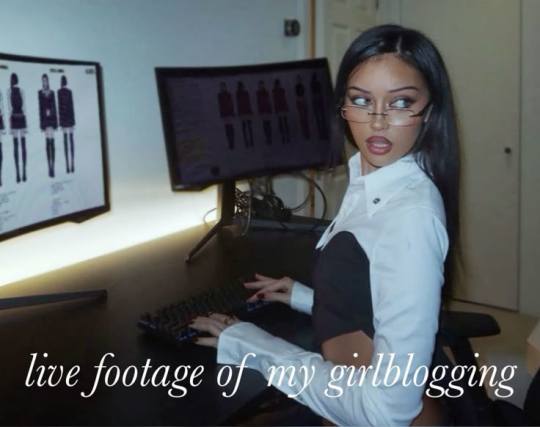

#astrology placements#astrology#astrology moodboard#astro blog#astro notes#astro news#astro observations#astro community#zodiac observations#zodiac signs#zodiac#astro seek#mars in cancer#horoscope#paid natal chart reading#natal chart reading#tarot reading#tarot and astrology#kpop astrology#kpop tarot#mercury retrograde#mercury in virgo#mercury in astrology#mercury in scorpio#mercury in leo#mercury in the 12th house#mercury in the houses#mercury in libra#mercury in 1st house#mercury astrology
426 notes
·
View notes
Text
HONEYS IT GIRL MAGAZINE september edition⋆.ೃ࿔*:・🎀

welcome back to honeys it girl magazine, this is the september catalog. get ready for the inside scoop on data that i've collected, things i've learned/started doing, and just general info like that organized in kind of a teen-magazine inspired fashion. a magazine for it girls ✨ and now please enjoy, the it girl magazine.



YOUR GUIDE TO VINTAGE GLAM ;
lately i've been OBSESSED with vintage glam. their makeup is so dramatized and utterly stunning and it just has this timeless elegance to it. so im super duper excited to dive into that in this catalogue…💬🎀
♡ a classic red lip
♡ winged eyeliner
♡ lush lashes
♡ defined brows (arched brows like betty boop)
♡ faux beauty marks
♡ soft eyeshadows
♡ a big bouncy blow out
♡ pearls and diamonds cuz diamonds are a girl's best friend
other details that can really capture the essence of a vintage glam look include pearl necklaces and earrings, cat-eye sunglasses, or a structured handbag. remember, its all about enhancing natural elegance with just the right amount of drama and UMPH.



you can see with this page of my fashion journal where i styled some vintage glam looks. so i incorporated silkier textures and long dresses for that old hollywood charm. idk what it is about hand gloves but they just SCREAM elegance and beauty so i incorporated that into the first outfit.
clutches are SO vintage glam and gorgeous and as u can see i incorporated pearls into the second outfit in the earrings, bracelet and neck piece.
FALL FASHION ;
fall fashion to me is tights and mini skirts. leg warmers and uggs and form fitting sweaters. let’s talk about some fall fashion. the tights and mini skirt combo is a classic and it’s an amazing way to incorporate wearing mini skirts even as the weather begins to get a little colder. the tights add a nice touch, even if it isn’t the color of ur skin tone, tights IN GENERAL look rly nice.



ankle boots, ugg boots, BOOTS are so so fall. i rly love ankle boots that have a heel to them and bonus points if ur fall shoes include fur. the fall shoes on my shopping list are ->
ugg boots
ankle boots
mary jane style shoes
ballet flats
form fitting sweaters and jackets are so in for the fall. along with tracksuits. the color pallete for having a bambi doll fall are very much browns, cashmeres, and baby pink. honestly think of neapolitan colours. pink, brown and an off-whitish almost pastel yellow. think PASTRY PRINCESS.
baby phat puffers are perfect for the transition from fall to winter and a good pair of jeans is CRUCIAL for fall. another thing i wanna talk about with fall fashion is LAYERING. layering is such an important aspect of fashion period but ESPECIALLY fall fashion. experiment with different lengths, textures etc. one of my favorite layering combination during the fall is ->



long sleeve tops with a camisole underneath
a form fitting long sleeve top (the ones with buttons at the front) look so DOLLY and adorable when u dont button it, and wear a camisole underneath. its just MWAH. some more fall fashion details also include ->
fur details
ribbons and lace details
delicate jewelry choices
tights and leg warmers
layering
boots
neopolitan cinnamon princess color scheme
long sleeves
mini skirts + tights combo
BEING A HOTTIE THIS FALL ;
fall is such an easy season to romanticize! and what better way to romanticize the fall then to make a pinterest board or a mood board. in this section of the magazine lets talk about things that u can do this fall to make ur fall SUPER memorable…💬🎀
♡ make cinnamon rolls (recipe is in the section before horoscope)
♡ go apple picking



♡ read a spooky/mystery novel
♡ pumpkin spice latte!
♡ invest in a yummy fall scented candle and light it often to make ur space smell like fall
fall beauty incorporates things like nude lip combos, warmer scents and french tips!…💬🎀
♡ soft bouncy curls
♡ nude lip combos



i recommend the nyx butter gloss (madeleine) and the nyx chocolate lip liner for a pretty chocolaty look. if ur looking for another nude lip combo use the nyx butter gloss (angel food cake) and the nyx club hopper lip liner…💬🎀
♡ french tips
♡ nude colored manicures and pedicures
♡ coffin and stiletto shaped nails
CINNAMON ROLLS RECIPE ;
nothing screams fall to me more than cinnamon rolls. they're just so yummy and cinnamony and so FALL. so here is a recipe to make ur very own cinnamon rolls this fall.
♡ in a mixing bowl, add 1 cup of warm milk
♡ 1/4 cup of sugar and 2 1/2 teaspoons of active dry yeast and give it a little mix
now set this aside for 5 minutes or until its frothed up. if it DOESNT froth up then ur yeast is not okay and ur gonna have to start again…💬🎀
♡ 4 2/3 cups of all purpose flour, 1/3 cup packed light brown sugar, 1/2 teaspoon of salt, half a teaspoon of cinnamon



♡ melt half a cup of butter and add it into the dry mixture and mix everything together in ur mixer but dont mix before adding 1 large egg and a tablespoon of vanilla extract
♡ now turn on ur mixture and knead the dough until its tacky but doesnt stick to ur fingers
♡ now get an oiled up bowl and put the dough in, and cover with a sheet. put it in a warm place so that then ur dough can rise (1 1/2 - 2 hours)
the reason why u have to wait so long is cuz the yeast is working rly hard to break down things like the milk and the butter so just be patient and excited cuz its gonna taste so good…💬🎀
♡ combine 1/2 cup of light brown sugar, 1 1/2 tablespoons of cinnamon and mix together with a fork



♡ once ur dough is done, make sure u flour up ur clean counter and put the dough onto it. with floured hands pat the dough and shape it, just kinda flatten it out
♡ spread out super soft butter across the dough and spread the cinnamon sugar we made over the dough in a nice even layer and once you've done that its time to roll the dough into a cylinder
♡ next butter ur baking dish, cut ur cinnamon rolls with some dental floss or string and place them in the dish, and make sure u give them room to grow
♡ cover them with a sheet again and put them in a warm place for 1 hour so that they can rise, once you've done that put them in the oven at 350 degrees for 20- 25 minutes
while the cinnamon rolls are baking, we'll make a luscious cream cheese icing to go on top of the cinnamon rolls once they're done…💬🎀
♡ combine 2 tablespoons of softened butter, along with 4 ounces of softened cream cheese, a pinch of salt and a teaspoon of vanilla extract and mix it with a hand mixer
♡ add 2 cups of powdered sugar and add a bit of milk as needed. if u want a thicker icing or a thinner one
♡ lastly add ur icing all over the top of ur cinnamon rolls once they're out of the oven and ENJOY
WHATS MY HOROSCOPE (SEPTEMBER 27-31) ;
♡ for virgo, when the sun enters libra on september 22, your self-esteem and natural talents are activated. with the ability to earn money and achieve success heightened, abundance flows. just be sure you’re saving, budgeting, and making wise investments. venus moves into scorpio on the same day, energizing your communication zone. surface-level connections will fall flat as you crave deeper, more intimate conversations. mercury enters libra on september 26, enhancing your powers of negotiation and manifestation.
♡ for aries, the energy changes when the sun enters libra on the twenty-second, activating your relationship sector. use this opportunity to strengthen your closest bonds, form alliances, and bring your romantic visions to life. venus enters scorpio the same day to awaken your realm of intimacy and money. you could find yourself drawn to mysterious people or situations. venus in motivated scorpio elevates your drive, making you an unstoppable force, especially regarding manifestation. this is an excellent time to negotiate. mercury enters libra on september 26, adding a dash of charm to communication with your loved ones.
♡ for taurus, the sun enters libra on september 22 and brings warmth to your realm of service and self-love. strive to create a healthy work/life balance. your relationships deepen when venus enters scorpio later the same day, bringing intensity to your closest connections. you could feel a stronger desire for intimacy and a pull toward mystery and secrets. be conscious of codependency and unrealistic expectations. mercury moves into harmony-seeking libra on september 26, encouraging solutions and charisma within your relationships.


♡ for gemini, you’re full of joy, creativity, and romance when the sun enters libra on september 22, activating your happiness sector. inspiration will be heightened, so pay attention to your ideas. when venus enters scorpio on the same day, it’s time to turn your attention inward. your desire to explore the depths of your mind, body, and soul intensifies, making this an excellent time to embrace self-care practices that promote greater self-love. mercury enters libra on september 26, awakening your charisma and warmth in communications.
♡ for cancer, when the sun enters air sign libra on september 22, you’ll feel ready to cozy up with your loved ones and enjoy the comforts of your environment. with your zone of intuition activated, your emotions will be powerful. venus enters scorpio on the same day, and your creativity will skyrocket. if you crave more romance, initiate it. mercury enters libra on september 26, encouraging you to share your real feelings.
♡ for leo, when the sun enters libra on september 22, you’ll feel eager to express your incredible ideas and connect with others. activating your communication sector, the libra sun enhances your natural charisma and creates ease in conversations. venus enters mysterious scorpio on the same day, prompting you to reflect on your emotional needs. your heart requires you to be assertive, especially with loved ones. mercury moves into peace-loving libra on september 26, inviting you to communicate from a place of neutrality.
♡ for libra, the sun enters your sign on september 22, ushering in a brand-new cycle. you’re the star of the show and your powers of manifestation are heightened. get ready for an exciting new chapter full of opportunity! venus enters scorpio on the same day, enhancing your ability to earn money. mercury enters your sign on september 26, which gives you the gift of clarity. share your ideas and express yourself. you will be well received.


♡ for scorpio, when the sun enters libra on september 22, your need for retreat and soul-searching is highlighted. over the next few weeks, you’ll find the most peace during moments of relaxation. the libra sun activates your imagination, so allow yourself moments to get lost in fantasy and embrace the fluidity and surrender it brings. venus enters your sign on the same day, prompting you to ardently pursue your deepest desires and ask for what you want. mercury enters libra on september 26, helping you process your subconscious thoughts.
♡ for sagittarius, you’re ready to connect with friends when the sun enters libra on september 22, energizing your zone of community. it’s an excellent time to collaborate with others and show up on social media. venus enters scorpio and your privacy sector on the same day, prompting you to take intentional time alone to get clear on your emotional needs. mercury enters libra on september 26, and exciting conversations take place.
♡ for capricorn, when the sun enters libra on september 22, your career and goals come into focus. you’re especially magnetic and charming, which bodes well for negotiations. find ways to creatively showcase your gifts and embrace your people skills to achieve success this season. recognition arrives when you show up confidently, so find ways to empower yourself. venus enters scorpio on the same day, bringing intimacy to your friendships. mercury moves into libra on september 26, offering you clarity on your goals and the ability to plan them.
♡ for aquarius, imagination and creativity are the keys to your success. you’ll feel ready for expansion and adventure when the sun enters libra on september 22, energizing your zone of exploration. plan an exciting excursion with loved ones or book a spiritual retreat. personal freedom will feel important for you, so be mindful of overcommitting yourself to serious tasks that feel like burdens. venus enters scorpio later the same day, motivating you to make power moves in your career. mercury enters libra on september 26, boosting your ability to learn quickly.
♡ for pisces, when the sun enters libra on september 22, your sights will be set on resources and intimacy. when it comes to your closest bonds, you’ll crave lots of privacy. your approach to money will feel more solution based, and you could tap into a new revenue stream. venus enters scorpio the same day, inviting you to take a chance. mercury moves into libra on september 26, activating your need for deep conversations.
#honeysitgirlmagazine✨💝#honeytonedhottie⭐️#it girl#becoming that girl#self concept#self care#that girl#self love#it girl energy#dream girl tips#dream girl#dream life#dreamy#hyper femininity#hyper feminine#girly#girl blog#it girl magazine#it girl lifestyle#it girl journey#princess#dolly#fashion#passion 4 fashion#girly magazine#horoscope#monthly catalogue#vintage#vintage glamour#old hollywood
482 notes
·
View notes
Text
struggling to reconcile my dislike of the use of “choice” in relation to transgenderism. sex assignment itself is not a choice and I don’t find it meaningful or helpful to think I “chose” to be transgender. in fact there were many things I “chose” to do prior to transitioning to make this feeling go away and it did not. Choice is further wrapped up in intentionally de-politicised ideas about social action and agency, constantly positioned in opposition to “structure” or “social pressure” or what have you. “Choice” is what happens only in the absence of domination, it is the expression of the “individual” trapped within us all. What this leaves you with is a subject who appears to rise above the power of history, making decisions ‘of his own free will’ in spite of all this violence as a result of, um, well that’s not important! Let’s not look at the law or the state or history to see where these ideas of personal individual freedoms come from or how they are themselves enforced through violence. It’s just an individual acting on his desires! To “choose to be trans” in popular consciousness means to be given the privilege of being free from patriarchal social pressures. And this is a line terfs often use - trans people are reinforcing patriarchy by deluding ourselves into thinking we can “simply choose” to be another gender. I think committing to the idea of choice as a concept and all its attendant ideological baggage (overwhelmingly structured by bourgeois legal frameworks in the popular imaginary) forces you into some deeply flawed analyses of power and domination.
And I likewise hate that the other dominant framework is “born this way/born in the wrong body” because of how it naturalises the very political and violent nature of sex assignment and its embeddedness within state census data, administrative architecture, the pathologisation of sex and desire (all of which are not natural or eternal), and so on. furthermore I deeply respect the position other trans people have when they say that they chose to be transgender - outside of conversations of individual validity, I think that is a politically useful and powerful way to position yourself. Even if we were to accept that being transgender is fully a choice, people would still do it, because being trans is not disgusting or shameful. I am not a sick individual, or a tragedy, or a danger to others, I am transgender and that is an incredibly meaningful and fulfilling part of my life. To frame this as a sexual perversion or life-long condition means reinforcing the idea that transgenderism is a shameful deformity (we have much in common with our disabled & intersex comrades in this regard), that the cissexual body is the exclusive site of beauty and authenticity.
And so this is where I find the idea of autonomy much more useful - while ‘choice’ is situated as a thing that individuals do, autonomy is power that is granted to you. I can’t meaningfully demand choice as a political goal, but I can demand autonomy. I don’t want choice, I want the autonomy to act on my desires, and the way that will happen is through the state provision of free hrt, surgery, name and gender marker changes, and so on. Autonomy feels like a much more productive articulation of “choice” because it necessitates that we think about who and what grants autonomy, for what purposes, in which contexts. Who gives a shit about choices! Transgenderism is not a social position an individual can have in society, it is produced through cissexualism, through state and medical sex assignment, through coercion and pathologisation and violence - all of which can be changed.
As a direct comparison, I don’t think people should be given the “choice” to have an abortion, but the autonomy to do so - sure you can choose to get one, but unless there is the medical, financial, and social infrastructure available to you to act on that decision, then that is not a meaningful choice you can “make.” Abortion being legal (and therefore an action you are granted the ‘choice’ to take) doesn’t mean it is actually realisable as a decision, it just means that whoever already has the power & resources to act on that legality will, and those that don’t, won’t. Who decides which people have those resources and which don’t? Well let’s not worry about that, the important thing is that people have choices!
#even old new york was once new amsterdam#also thinking abt indigenous interactions with settler law and the use of ‘sovereignty’ as an articulation of indigenous rights & power#I’m less familiar with those histories (& mostly limited to the Canadian context) so I feel less sure making those comparisons#but like I remember reading an article in undergrad about the difference between food ‘choice’ & food ‘sovereignty’#the former being limited to what options are provided & the latter being the granting of power to decide on those options#and both of these come from the state! I think being given the choice and given the autonomy to do something are different#but they both are granted by the state & are similarly political. Choice just hides that fact through branding & liberalism & etc
401 notes
·
View notes
Note
Is AWAY using it's own program or is this just a voluntary list of guidelines for people using programs like DALL-E? How does AWAY address the environmental concerns of how the companies making those AI programs conduct themselves (energy consumption, exploiting impoverished areas for cheap electricity, destruction of the environment to rapidly build and get the components for data centers etc.)? Are members of AWAY encouraged to contact their gov representatives about IP theft by AI apps?
What is AWAY and how does it work?
AWAY does not "use its own program" in the software sense—rather, we're a diverse collective of ~1000 members that each have their own varying workflows and approaches to art. While some members do use AI as one tool among many, most of the people in the server are actually traditional artists who don't use AI at all, yet are still interested in ethical approaches to new technologies.
Our code of ethics is a set of voluntary guidelines that members agree to follow upon joining. These emphasize ethical AI approaches, (preferably open-source models that can run locally), respecting artists who oppose AI by not training styles on their art, and refusing to use AI to undercut other artists or work for corporations that similarly exploit creative labor.
Environmental Impact in Context
It's important to place environmental concerns about AI in the context of our broader extractive, industrialized society, where there are virtually no "clean" solutions:
The water usage figures for AI data centers (200-740 million liters annually) represent roughly 0.00013% of total U.S. water usage. This is a small fraction compared to industrial agriculture or manufacturing—for example, golf course irrigation alone in the U.S. consumes approximately 2.08 billion gallons of water per day, or about 7.87 trillion liters annually. This makes AI's water usage about 0.01% of just golf course irrigation.
Looking into individual usage, the average American consumes about 26.8 kg of beef annually, which takes around 1,608 megajoules (MJ) of energy to produce. Making 10 ChatGPT queries daily for an entire year (3,650 queries) consumes just 38.1 MJ—about 42 times less energy than eating beef. In fact, a single quarter-pound beef patty takes 651 times more energy to produce than a single AI query.
Overall, power usage specific to AI represents just 4% of total data center power consumption, which itself is a small fraction of global energy usage. Current annual energy usage for data centers is roughly 9-15 TWh globally—comparable to producing a relatively small number of vehicles.
The consumer environmentalism narrative around technology often ignores how imperial exploitation pushes environmental costs onto the Global South. The rare earth minerals needed for computing hardware, the cheap labor for manufacturing, and the toxic waste from electronics disposal disproportionately burden developing nations, while the benefits flow largely to wealthy countries.
While this pattern isn't unique to AI, it is fundamental to our global economic structure. The focus on individual consumer choices (like whether or not one should use AI, for art or otherwise,) distracts from the much larger systemic issues of imperialism, extractive capitalism, and global inequality that drive environmental degradation at a massive scale.
They are not going to stop building the data centers, and they weren't going to even if AI never got invented.
Creative Tools and Environmental Impact
In actuality, all creative practices have some sort of environmental impact in an industrialized society:
Digital art software (such as Photoshop, Blender, etc) generally uses 60-300 watts per hour depending on your computer's specifications. This is typically more energy than dozens, if not hundreds, of AI image generations (maybe even thousands if you are using a particularly low-quality one).
Traditional art supplies rely on similar if not worse scales of resource extraction, chemical processing, and global supply chains, all of which come with their own environmental impact.
Paint production requires roughly thirteen gallons of water to manufacture one gallon of paint.
Many oil paints contain toxic heavy metals and solvents, which have the potential to contaminate ground water.
Synthetic brushes are made from petroleum-based plastics that take centuries to decompose.
That being said, the point of this section isn't to deflect criticism of AI by criticizing other art forms. Rather, it's important to recognize that we live in a society where virtually all artistic avenues have environmental costs. Focusing exclusively on the newest technologies while ignoring the environmental costs of pre-existing tools and practices doesn't help to solve any of the issues with our current or future waste.
The largest environmental problems come not from individual creative choices, but rather from industrial-scale systems, such as:
Industrial manufacturing (responsible for roughly 22% of global emissions)
Industrial agriculture (responsible for roughly 24% of global emissions)
Transportation and logistics networks (responsible for roughly 14% of global emissions)
Making changes on an individual scale, while meaningful on a personal level, can't address systemic issues without broader policy changes and overall restructuring of global economic systems.
Intellectual Property Considerations
AWAY doesn't encourage members to contact government representatives about "IP theft" for multiple reasons:
We acknowledge that copyright law overwhelmingly serves corporate interests rather than individual creators
Creating new "learning rights" or "style rights" would further empower large corporations while harming individual artists and fan creators
Many AWAY members live outside the United States, many of which having been directly damaged by the US, and thus understand that intellectual property regimes are often tools of imperial control that benefit wealthy nations
Instead, we emphasize respect for artists who are protective of their work and style. Our guidelines explicitly prohibit imitating the style of artists who have voiced their distaste for AI, working on an opt-in model that encourages traditional artists to give and subsequently revoke permissions if they see fit. This approach is about respect, not legal enforcement. We are not a pro-copyright group.
In Conclusion
AWAY aims to cultivate thoughtful, ethical engagement with new technologies, while also holding respect for creative communities outside of itself. As a collective, we recognize that real environmental solutions require addressing concepts such as imperial exploitation, extractive capitalism, and corporate power—not just focusing on individual consumer choices, which do little to change the current state of the world we live in.
When discussing environmental impacts, it's important to keep perspective on a relative scale, and to avoid ignoring major issues in favor of smaller ones. We promote balanced discussions based in concrete fact, with the belief that they can lead to meaningful solutions, rather than misplaced outrage that ultimately serves to maintain the status quo.
If this resonates with you, please feel free to join our discord. :)
Works Cited:
USGS Water Use Data: https://www.usgs.gov/mission-areas/water-resources/science/water-use-united-states
Golf Course Superintendents Association of America water usage report: https://www.gcsaa.org/resources/research/golf-course-environmental-profile
Equinix data center water sustainability report: https://www.equinix.com/resources/infopapers/corporate-sustainability-report
Environmental Working Group's Meat Eater's Guide (beef energy calculations): https://www.ewg.org/meateatersguide/
Hugging Face AI energy consumption study: https://huggingface.co/blog/carbon-footprint
International Energy Agency report on data centers: https://www.iea.org/reports/data-centres-and-data-transmission-networks
Goldman Sachs "Generational Growth" report on AI power demand: https://www.goldmansachs.com/intelligence/pages/gs-research/generational-growth-ai-data-centers-and-the-coming-us-power-surge/report.pdf
Artists Network's guide to eco-friendly art practices: https://www.artistsnetwork.com/art-business/how-to-be-an-eco-friendly-artist/
The Earth Chronicles' analysis of art materials: https://earthchronicles.org/artists-ironically-paint-nature-with-harmful-materials/
Natural Earth Paint's environmental impact report: https://naturalearthpaint.com/pages/environmental-impact
Our World in Data's global emissions by sector: https://ourworldindata.org/emissions-by-sector
"The High Cost of High Tech" report on electronics manufacturing: https://goodelectronics.org/the-high-cost-of-high-tech/
"Unearthing the Dirty Secrets of the Clean Energy Transition" (on rare earth mineral mining): https://www.theguardian.com/environment/2023/apr/18/clean-energy-dirty-mining-indigenous-communities-climate-crisis
Electronic Frontier Foundation's position paper on AI and copyright: https://www.eff.org/wp/ai-and-copyright
Creative Commons research on enabling better sharing: https://creativecommons.org/2023/04/24/ai-and-creativity/
193 notes
·
View notes
Text
'Why creatives are seeking residuals' - thread by Stefanie Williams

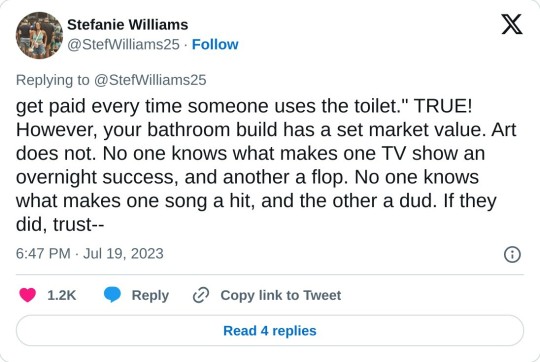
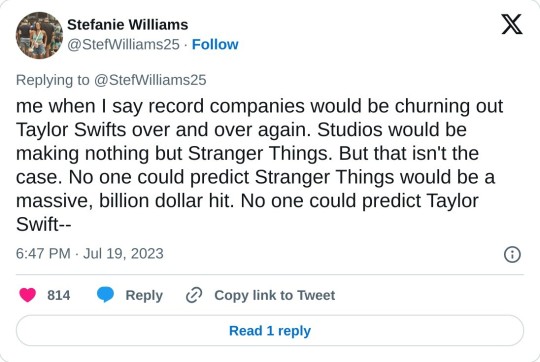
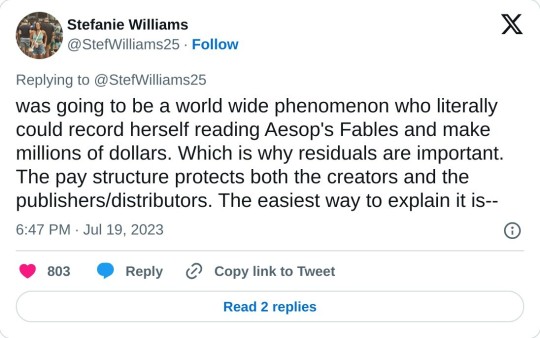
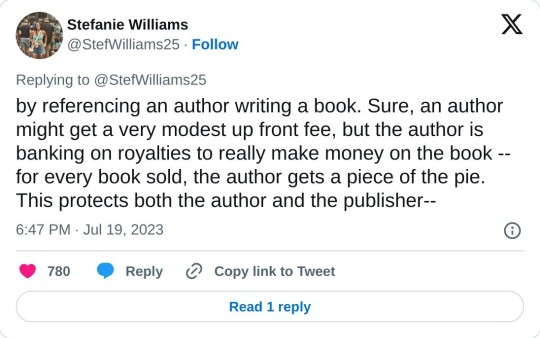
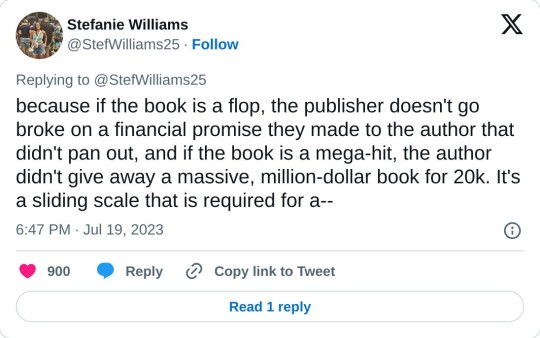
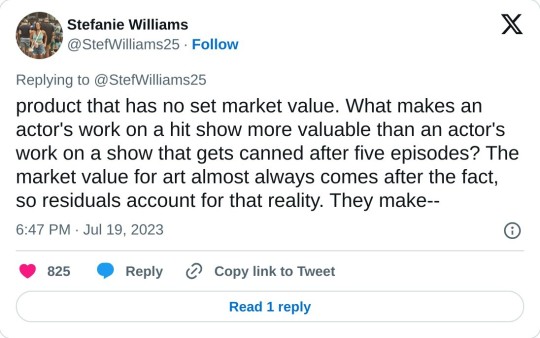
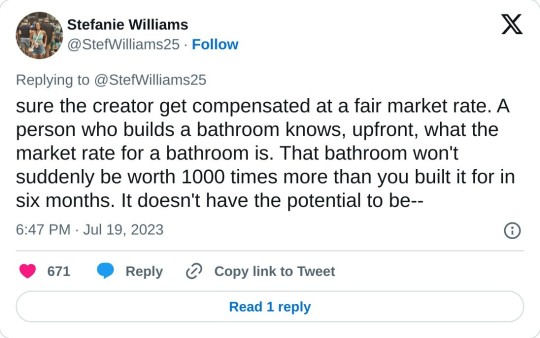
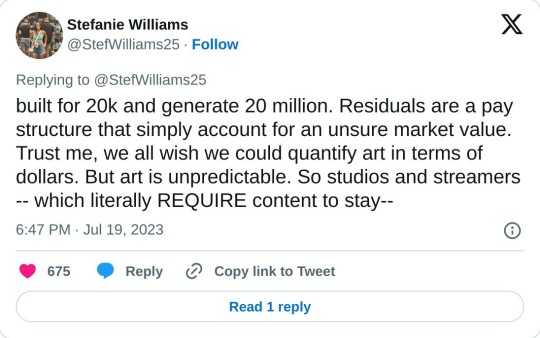
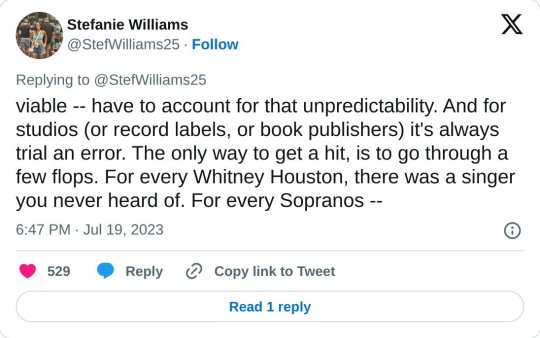
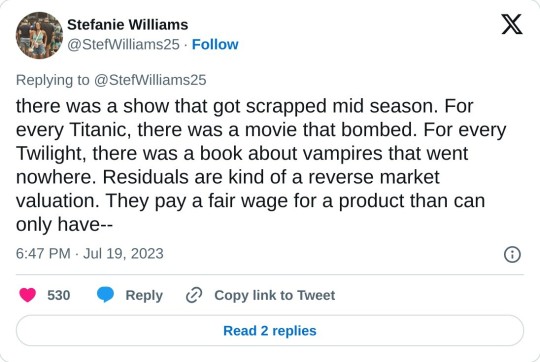
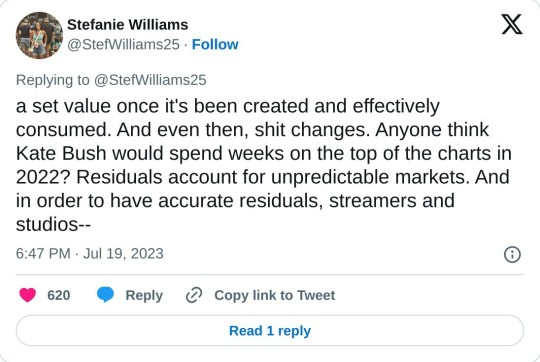
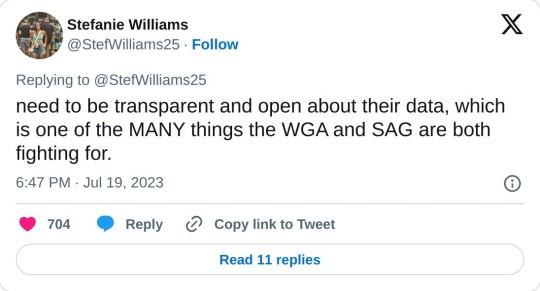
[Tweet thread by Stefanie Williams @/StefWilliams25
TRANSCRIPT:
Why creatives are seeking residuals vs. "do you pay the mattress maker every time you sleep on a mattress?" A thread. I keep hearing over and over again that writers/actors/creatives don't deserve residuals for the work they create. "If I build a bathroom in a house, I don't get paid every time someone uses the toilet."
TRUE! However, your bathroom build has a set market value. Art does not. No one knows what makes one TV show an overnight success, and another a flop. No one knows what makes one song a hit, and the other a dud. If they did, trust me when I say record companies would be churning out Taylor Swifts over and over again. Studios would be making nothing but Stranger Things.
But that isn't the case. No one could predict Stranger Things would be a massive, billion dollar hit. No one could predict Taylor Swift was going to be a world wide phenomenon who literally could record herself reading Aesop's Fables and make millions of dollars. Which is why residuals are important. The pay structure protects both the creators and the publishers/distributors.
The easiest way to explain it is by referencing an author writing a book. Sure, an author might get a very modest up front fee, but the author is banking on royalties to really make money on the book — for every book sold, the author gets a piece of the pie. This protects both the author and the publisher—because if the book is a flop, the publisher doesn't go broke on a financial promise they made to the author that didn't pan out, and if the book is a mega-hit, the author didn't give away a massive, million-dollar book for 20k.
It's a sliding scale that is required for a product that has no set market value. What makes an actor's work on a hit show more valuable than an actor's work on a show that gets canned after five episodes? The market value for art almost always comes after the fact, so residuals account for that reality. They make sure the creator get compensated at a fair market rate. A person who builds a bathroom knows, upfront, what the market rate for a bathroom is. That bathroom won't suddenly be worth 1000 times more than you built it for in six months. It doesn't have the potential to be built for 20k and generate 20 million.
Residuals are a pay structure that simply account for an unsure market value. Trust me, we all wish we could quantify art in terms of dollars. But art is unpredictable. So studios and streamers -- which literally REQUIRE content to stay viable -- have to account for that unpredictability. And for studios (or record labels, or book publishers) it's always trial and error. The only way to get a hit, is to go through a few flops.
For every Whitney Houston, there was a singer you never heard of. For every Sopranos, there was a show that got scrapped mid season. For every Titanic, there was a movie that bombed. For every Twilight, there was a book about vampires that went nowhere. Residuals are kind of a reverse market valuation. They pay a fair wage for a product than can only have a set value once it's been created and effectively consumed.
And even then, shit changes. Anyone think Kate Bush would spend weeks on the top of the charts in 2022? Residuals account for unpredictable markets. And in order to have accurate residuals, streamers and studios need to be transparent and open about their data, which is one of the MANY things the WGA and SAG are both fighting for.
#sag-aftra strike#sag strike#actors strike#union solidarity#support unions#fans4wga#described#wga strike#writers strike
3K notes
·
View notes
Text
"The coral reefs of south Sulawesi are some of the most diverse, colorful and vibrant in the world. At least, they used to be, until they were decimated by dynamite fishing in the 1990s.
As part of a team of coral reef ecologists based in Indonesia and the UK, we study the reefs around Pulau Bontosua, a small Indonesian island in south Sulawesi...
In many places around the world, damage like this might be described as irreparable. But at Pulau Bontosua, the story is different. Here, efforts by the Mars coral restoration program have brought back the coral and important ecosystem functions, as outlined by our new study, published in Current Biology. We found that within just four years, restored reefs grow at the same rate as nearby healthy reefs.
Speedy recovery
The transplanted corals grow remarkably quickly. Within a year, fragments have developed into proper colonies. After two years, they interlock branches with their neighbors. After just four years, they completely overgrow the reef star structures and restoration sites are barely distinguishable from nearby healthy reefs.
The combined growth of many corals generates a complex limestone (calcium carbonate) framework. This provides a habitat for marine life and protects nearby shorelines from storm damage by absorbing up to 97% of coastal wave energy.
We measured the overall growth of the reef framework by calculating its carbonate budget. That's the balance between limestone production (by calcifying corals and coralline algae) and erosion (by grazing sea urchins and fishes, for example). A healthy reef produces up to 20kg of reef structure per square meter per year, while a degraded reef is shrinking rather than growing as erosion exceeds limestone production. Therefore, overall reef growth gives an indication of reef health.
At Pulau Bontosua, our survey data shows that in the years following restoration, coral cover, coral colony sizes, and carbonate production rates tripled. Within four years, restored reefs were growing at the same speed as healthy reefs, and thereby provided the same important ecosystem functions...
Outcomes of any reef restoration project will depend on environmental conditions, natural coral larvae supply, restoration techniques and the effort invested in maintaining the project. This Indonesian project shows that when conditions are right and efforts are well placed, success is possible. Hopefully, this inspires further global efforts to restore functioning coral reefs and to recreate a climate in which they can thrive."
-via Phys.org, March 11, 2024
#coral#coral reef#marine life#marine biology#sea creatures#aquatic#environment#ecology#environmental news#environmental science#climate action#climate hope#ecosystem#conservation#endangered species#indonesia#sulawesi#good news#hope#overfishing#hopepunk#hope posting
6K notes
·
View notes
Text
I was never really certain about my transition in the way that most gatekeeping hormone prescribers and curious members of the public demand that a trans person be. I didn’t “always know” that I was not cisgender. I haven’t “always known” anything about myself. Very few truths about me have always remained true, my existence is too interpersonal, contextual, and ever-evolving for all of that. (So is most everyone else’s, I think). I don’t think that the fact I’d eventually choose to exercise my body autonomy at age 30 by taking hormones is a decision I could have foreseen when I was a child. All that I knew about being transgender when I was a kid was a fact that most children intuitively know: gender assignment was a violation of my freedom, of everyone’s freedom in fact, and it was wrong. As an infant and then a child and teenager, people kept imposing labels on me; they kept forcing me and my body into prescribed gendered boxes, and while the specific labels and boxes never really felt like the right ones, the most disturbing part about it all was the forcing. No coerced identity would have ever felt right. Children can tell when secrets are being kept from them, and when adults are restricting their choices. They notice that they and the other children are being lined up boy-girl, boy-girl, without ever being told what a girl or a boy even is. They can see their parents frowning when they reach for the doll with the shimmery hair, or climb atop the neighbor kid on the playground. Kids know that they are forbidden from sitting with their legs spread wide or flicking their wrist, and their gender illegibility is shamed in them, long before they get any answers about what gender means or where it comes from or why it’s so important that they make themselves easy to understand.
Like the cloned children in Never Let Me Go who grow up being conditioned for a life of forced organ donation, children in a cissexist society grow up conditioned to fall within certain gendered boundary lines, and by the time they learn that the reason for this is almost completely arbitrary, they can’t imagine any alternative. Not until some of them hear about gender transition and find the prospect very compelling, for some reason. You can say that reason is because some of us are inherently trans, but there’s absolutely nothing in the way of brain science, genetics research, or even sociological data to back that up. Besides, the search for a biological “reason” that people are transgender or queer runs counter to the goal of queer liberation in the long run. Science only needs to explain the existence of transgender people (or queer people more broadly) if our existence is in some way aberrant or a problem. If queerness is accepted as a form of human diversity that simply exists, then there is no need to excuse it by claiming that it is never a choice. It can be a choice, if a person wants to make it, and hopefully it satisfies them, but maybe it won’t. Freedom to choose means freedom to forever be dissatisfied, to search endlessly for more, and yes, to capable of making a mistake. I would say that viewing myself as transgender was a choice. I decided to break away from the straight, female categories to which I had been assigned, and doing so allowed me to view the legal and societal power structures that had restricted me more clearly. It helped me better understand myself. But that does not mean the actual act of breaking away was always the truest reflection of who I am. The version of me that transitioned was a person on the run — and how a person behaves, thinks, and self-conceives when they are fleeing is not a great reflection of whom they might be if they were safe. If we all lived in a world free from mandatory gender assignment, and where our bodies were not mined for meaning about the kinds of sex we liked, the clothing we should wear, the personality qualities we have, the roles we should play in society, and the connections we are allowed to form with others, who knows who each of us might be. But none of us get to live in that world, or ever gets completely free from the frameworks of heterosexuality and the gender binary. These frameworks shape every legal institution we encounter, every school we attend, every item of clothing we put on, every substance we take into our bodies, every piece of paperwork that ever gets printed about us, and every look another person ever gives us. And so we make due with rewriting and recombining those frameworks as best we can. It should come as no surprise that those us who break away from the binary have to experiment and revise how we understand ourselves quite a bit — sometimes getting things “wrong,” sometimes searching forever for the semblance of something “right.” Sometimes reveling in the “wrongness” of all the available options is kind of the point.
I wrote about my detransition, retransition, and the eternal dissatisfaction that is probably the corest truth of my identity. It's free to read or have narrated to you on my Substack.
634 notes
·
View notes
Text
Interview to celebrate the opening of the Ryoko Kui Exhibition
About Delicious in Dungeon: Story making
Q1. Your first long-running series has lasted for about 9 and a half years. Has it been different from your previous experience drawing short stories?
A1. Compared to short stories, the series has been easier because the same characters appear each time. But I was surprised to find that I got tired of drawing the same characters too many times.
Q2. You have said before that the overall structure of the story was decided before serialization began, but how much of that had you communicated to your editor? Also, what kind of communication did you have during the series production?
A2. The goal was something we discussed and had decided on from the beginning. The goal itself was simple, but the path to get there was more difficult and took longer than imagined.
Q3. Regarding the overall story concept and development, did you write out or put anything down in writing (such as the plot)?
A3. I did, but it was simple.
Q4. Did you come up with the dishes based on the monsters you wanted in the story? Or did you come up with the monsters based on the dishes?
A4. It depended on the story, but usually the story came first followed by the monsters or food. I feel like that was most often the order.
Q5. As you progressed in drawing the series, what elements of the characters, story, or world expanded or grew in the most unexpected way?
A5. Nothing particularly unexpected perhaps. When I used to draw web manga, I tended to think up inconsequential settings. So, from the beginning I tried to restrain myself as much as possible and not expand too much. I was surprised when my editor said "Let's expand it more," in the second half of the series.
Q6. "Delicious in Dungeon" starts with a relatively simple setting, but as the series and the labyrinth exploration continues, the map slowly expands little by little in the readers' minds. It becomes more three-dimensional, revealing the secrets of the world, and taking on a multilayered structure. Are there any sources that you used as a reference, or which influenced you in creating this multilayered structure?
A6. A long time ago, when I was working on my personal web manga (fantasy), I drew it however I wanted, thinking that "Only people who can read this will read it," but I regularly received feedback that it was "unreadable", so I tried to make it as easily. accessible as possible.
Q7. The series combines many elements, including "fantasy", "gourmet", "battles", and "puzzle solving", but I think it's also important that it is a "comedy" which makes people laugh. Could you let us know if you have a creative commitment towards depicting humor?
A7. My hopes are that I can make it fun for people to read.
[page 5]
About Delicious in Dungeon: Drawing manga
Q1. Please tell us about the drawing tools you currently use, both digital and analogue.
A1. In terms of analogue tools, I use a light box, a G pen, a round pen, and a brush pen. And for digital, I use CLIP STUDIO PAINT and a Wacom LCD tablet. Screentone pasting is always done on the computer, so ultimately it all ends up as a digital manuscript.
Q2. Do you have any rules or reasons for using digital and analog separately?
A2. I'm always looking for ways to draw better and save time, so the exact approach is probably different for almost every chapter. Personally, I feel that analogue methods create more appealing lines, but I feel like digital saves time, so maybe I'll do a digital rough sketch and do the inking by hand… I might have been using a G pen, and maybe I'll try out a turnip pen, or this time I'm short on time so I'll draw it entirely digitally, but with digital I can redo it over and over, so maybe analogue is still faster, and so on and so forth. I'm indecisive in this way and so haven't developed a consistent process.
Q3. I understand that you prepare 3D data for your assistants to draw the backgrounds. What kind of data did you make for "Delicious in Dungeon" ?
A3. You could call it 3D, but it's not a proper model, just something to help with the rough sketching. I line up cubes to share the perspective and sense of scale, and they use it as a reference.
Q4. At the beginning of the series, the characters and backgrounds were somewhat simply drawn, and it seems like they became richly detailed over the progression of the story. What was your intention behind using these different styles?
A4. It's simply that my technique isn't stable. I thought I'd put a lot of effort in at the start. I remember being confused when my editor asked me to add more in to the drawing, and I wondered "Where…?"
Q5. Thinking about the food, were there any menu illustrations that you were particularly satisfied with, or which you struggled with?
A5. I've never liked my own food illustrations. But the times when I read other people's manga and thought "That looks delicious," I think it's been more an influence of the movement, the staging, and the situation than the drawings.
Q6. For the world maps and the terrain of each continent, did you refer to any maps of the real world? I feel like the shape of the 'island' is similar to the shape of Fukuoka Prefecture or Kyushu.
A6. I didn't reference any specific geography, but I did try to put thought into things like whether a developed city would be near a river or the sea, and what the coastline would look like. I'm pleased if it feels similar to a real place, because it means my interpretation was pretty accurate.
About Delicious in Dungeon: Other
Q1. Which is your favorite monster?
A1. Nightmare.
Q2. I'm sure you have received a lot of feedback from readers in countries and regions outside of Japan. Please tell us if there was anything from them that made you happy, was unexpected, or which made a lasting impression on you.
A2. When you play foreign games, there are times when you think "Why did they translate it into Japanese like that?" But having been on the side of having something translated, I've realized some things are unavoidable, or endless, and there are many things that don't matter either way from the author's perspective, so it was interesting.
About Ryoko Kui's short story collections and herself
Q1. Dragons are a consistent and important motif in your work. Was there any particular work or experience which inspired this? Also, are there points about drawing dragons which you find interesting or have had to work hard on?
A1. It's less about liking dragons, and more that I'm interested in the worlds in which dragons exist. When I draw dragons, the depiction in itself has a sweet feeling to it. I have never had a pet reptile, so I don't have a very good understanding of them.
Q2. Unomiya University in your story "The dragon's school is on top of the mountain" has a Faculty of Dragons, Department of Environmental Studies, and Department of Technology Studies, and a Faculty of Veterinary Medicine. If you were to enroll in the university, which department or faculty would you like to enter?
A2. I probably wouldn't be accepted….
Q3. The collection includes a short story staged as an essay manga. Are you a fan of essay manga? Please tell us about any genres of essay manga that you like.
A3. I love all kinds of essay manga. I read them often.
Q4. If you were to make your own game, what kind of game would you like to make?
A4. I prefer being a player when it comes to games.
Q5. When did you first start drawing illustrations (doodles)?
A5. I don't exactly remember when I first drew a picture, but I think I started drawing manga around the fourth or fifth grade of elementary school. in my notebooks and had my friends read them.
Q6. What is the most fun part about drawing manga?
A6. Every part is fun and hard in its own way.
Q7. Please tell us if there is anything you "just can't stop no matter what".
A7. My procrastination habit.
Q8. Could you please tell us if there's something you want to draw now?
A8. I've been working continuously since the serialization, so I'd like to take about 2 to 3 months to just draw whatever I want.
#Dungeon Meshi#qna#Ryoko Kui#longpost#long post#ryoko kui exhibition#delicious in dungeon exhibition#interview#delicious in dungeon#dunmeshi#exhibition
280 notes
·
View notes
Text
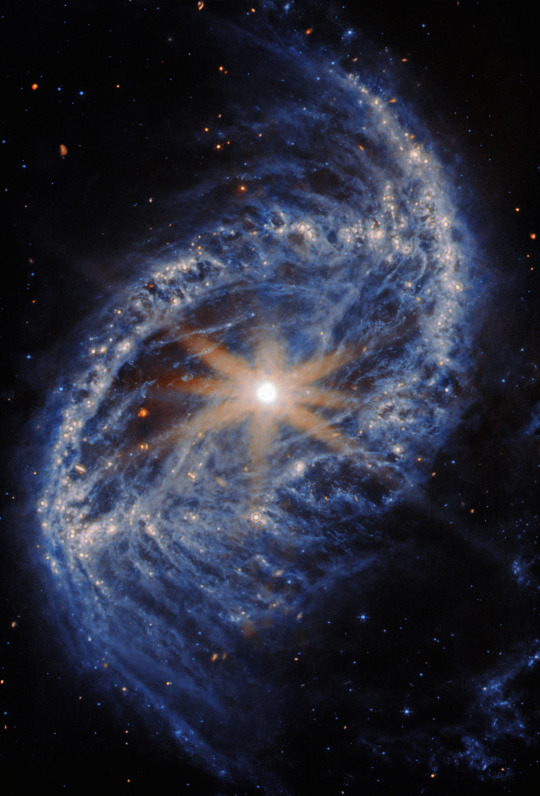
NGC 2566 (MIRI image)
The galaxy filling the frame in this NASA/ESA/CSA James Webb Space Telescope Picture of the Month is NGC 2566, a spiral galaxy located in the constellation Puppis. In this image Webb’s Mid-InfraRed Instrument (MIRI) puts the thick clouds of interstellar dust that suffuse NGC 2566 on display, as well as the galaxy’s compact, bright core.
At 76 million light-years away, NGC 2566 is considered a nearby galaxy, making it an excellent target for studying fine details like star clusters and gas clouds. The new Webb images of NGC 2566 were collected as part of an observing programme (#3707) dedicated to understanding the connections between stars, gas and dust in nearby star-forming galaxies. NGC 2566 is just one of the 55 galaxies in the local Universe examined by Webb for this programme.
To gain a full understanding of the star-formation process in nearby galaxies, astronomers will combine Webb data with observations from other telescopes. At the long-wavelength end of the electromagnetic spectrum, the 66 radio dishes of the Atacama Large Millimeter/submillimeter Array (ALMA) provide a detailed view of the cold, turbulent clouds where stars are born. The NASA/ESA Hubble Space Telescope has also cast its gaze on NGC 2566, and a new Hubble image of this galaxy was released earlier this week. The Hubble data will help researchers take a census of the stars in nearby galaxies, especially the young stars that are bright at the ultraviolet and visible wavelengths to which Hubble is sensitive. Together, the Webb, Hubble and ALMA data provide a rich view of the cold gas, warm dust and brilliant stars in NGC 2566.
The Webb data are part of a Treasury programme, which means that the data may help answer multiple important questions about our Universe. Treasury data are available for use by scientists and the public without a waiting period, amplifying the scientific impact and allowing exploration to begin immediately.
[Image Description: A spiral galaxy, seen close-up. Its core is a round spot that glows intensely bright, crowned by eight long and spikes that extend across the galaxy, artefacts of the telescope’s structure. Its disc is an oval shape with edges made of very thick and cloudy arms of gas and dust, mostly blue but paler and brighter around patches of stars. Wisps of darker dust also fill the inner disc and swirl off the ends of the arms.]
Credits: ESA/Webb, NASA & CSA, A. Leroy;
155 notes
·
View notes
Text
Also preserved in our archive
Every infection, no matter how mild, has a cumulative effect on your brain, reducing gray matter and altering function. Mask up. Keep yourself and others safe from a disease that can and will cause many varied lingering issues.
by Denis Storey
Clinical relevance: New research shows that even mild COVID-19 cases in young adults can lead to changes in brain structure and function.
Researchers found reduced connectivity in key brain regions, including the left hippocampus and amygdala. These changes were linked to deficits in spatial working memory and cognitive performance. The study highlights the need for further research into long-term neurological effects of COVID-19, even in mild cases. For all the damage the pandemic’s done, it seems as if the youngest generations will pay the steepest price. The latest proof of that has emerged in new research that’s discovered that even the mildest of COVID cases among young adults can lead to changes in brain structure and function. As a result, it could pose a threat to long-term cognitive performance.
The research provides new insight into the potential neurological impact of SARS-CoV-2 in populations that avoided severe illness. The study focused on adolescents and young adults since it’s a group that’s remained relatively understudied.
Methodology The study, part of the Public Health Impact of Metal Exposure (PHIME) cohort, included 40 participants. More than a dozen of them – 13 – tested positive for COVID-19, while 27 served as controls.
The researchers enrolled the participants in a longitudinal study, which offered pre-pandemic baseline data through MRI scans and cognitive assessments. This allowed the team a unique look into pre- and post-pandemic neural outcomes.
The researchers relied on the latest neuroimaging technology, such as resting-state functional MRI (fMRI) and structural MRI, to examine shifts in brain connectivity and cortical volume.
The researchers also subjected the participants to cognitive testing focused on spatial working memory. The team conducted the assessments both before the COVID-19 pandemic and after recovery from mild COVID-19 cases. These parallel evaluations allowed for a direct comparison of brain and cognitive changes.
COVID Affected Multiple Brain Regions The study exposed notable differences between COVID-19-positive and healthy participants in five critical brain regions:
The right intracalcarine cortex. The right lingual gyrus. The left hippocampus. The left amygdala. And the left frontal orbital cortex. Perhaps most notably, the left hippocampus revealed a significant drop in cortical volume among those who’d tested positive for COVID.
Researchers also found that the left amygdala showed much lower connectivity in participants who’d contracted COVID-19. This lack of connectivity appeared to be linked to deficits in spatial working memory. From this, the researchers inferred that even mild COVID-19 infection could impair one’s ability to perform tasks that rely on short-term memory.
Backing Up Previous Research The study results echo a mounting body of literature that suggests that COVID-19, despite its nature as a respiratory virus, appears to have far-reaching neurological implications. Earlier research has linked more serious cases of the virus with reduced gray matter thickness and cerebral volume loss, particularly in the hippocampus and amygdala.
The researchers add that the brain changes they observed could be related to the neurotoxic effects of SARS-CoV-2, which could have a lingering influence even among milder caes of infection. The paper’s authors theorize that it could be because the virus might be invading the brain through the olfactory system. That could cause inflammation and damage in important neural regions.
On the other hand, the authors also posit that the social and psychological stressors of the pandemic – whether its the social isolation or the lingering uncertainties – could be a factor in the changes appearing in the brains of the COVID-positive participants.
These results underscore the necessity for more research into the long-term neurological effects of the pandemic, especially among its younger survivors.
Moving Forward Finally, the research team hints that further investigation could clarify whether these neurological changes are permanent, and – if not – how long they might last.
The authors conclude by insisting that this study offers crucial new insight into the potentially long-term ramifications of COVID on the brain, even in mild cases. As we struggle with life in the shadow of the pandemic, a better grasp of what it means for everyone who’s been infected could help us develop more effective treatments.
#mask up#public health#wear a mask#pandemic#wear a respirator#covid#still coviding#covid 19#coronavirus#sars cov 2#long covid#covid conscious#covid19#covid is not over
150 notes
·
View notes